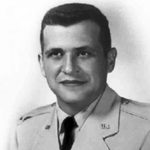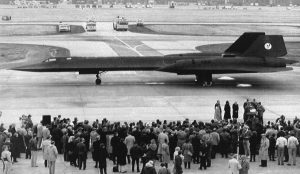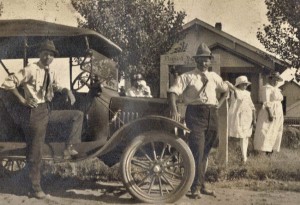memores

 On May 1, 1960, CIA U-2 spy plane pilot, Gary Powers found himself in a lot of trouble. His plane was disabled after being hit by Soviet surface-to-air missiles. Powers had to let his plane fall from 70,000 feet to 30,000 feet before he could release himself and bail out of the damaged cockpit. It was 1960…and the Cold War was heating up. Powers was captured, and would remain a prisoner of war until a prisoner exchange on February 10, 1962. The United States now needed a plane that was safer for these men to fly. Something that went higher and faster than any other plane, and had a minimal radar cross section. It was imperative to have such an innovative aircraft so the United States could improve intelligence gathering. Enter Lockheed’s advanced development group, the Skunk Works® in Burbank. This team had already begun work on such an aircraft.
On May 1, 1960, CIA U-2 spy plane pilot, Gary Powers found himself in a lot of trouble. His plane was disabled after being hit by Soviet surface-to-air missiles. Powers had to let his plane fall from 70,000 feet to 30,000 feet before he could release himself and bail out of the damaged cockpit. It was 1960…and the Cold War was heating up. Powers was captured, and would remain a prisoner of war until a prisoner exchange on February 10, 1962. The United States now needed a plane that was safer for these men to fly. Something that went higher and faster than any other plane, and had a minimal radar cross section. It was imperative to have such an innovative aircraft so the United States could improve intelligence gathering. Enter Lockheed’s advanced development group, the Skunk Works® in Burbank. This team had already begun work on such an aircraft.
President Dwight D Eisenhower was very impressed with the U-2’s airborne reconnaissance during these tense Cold War times, but with the need for better protection for the pilots, Eisenhower’s request went out to Lockheed to build the impossible…an aircraft that can’t be shot down…and do it fast. American aerospace engineer Clarence “Kelly” Johnson was one of the preeminent aircraft designers of the twentieth century. He and his Skunk Works team had a track record of delivering impossible technologies on incredibly short, strategically critical deadlines. Still, everything for this project had to be invented. The group was known for its unfailing sense of duty, its creativity in the face of a technological challenge and its undaunted perseverance. Be that as it may, this new aircraft was in a different category from anything that had come before. This would be the toughest assignment Skunk Works had ever been assigned…at least up to that date. They needed to have the previously unheard of type of aircraft flying in a mere twenty months.
The Lockheed SR-71 “Blackbird” was that long-range, Mach 3+ strategic reconnaissance aircraft, and was operated by the United States Air Force. It was developed as a top secret black project by the Lockheed company. During aerial reconnaissance missions, the SR-71 operated at high speeds and altitudes to allow it to outrace threats. If a surface-to-air missile launch was detected, the standard evasive action was simply to accelerate and outfly the missile. The SR-71 was designed with a reduced radar cross-section, making it harder to spot. The SR-71 served with the U.S. Air Force from 1964 to 1998. A total of 32 aircraft were built. Twelve were lost 
 in accidents, but none of them to enemy action. The SR-71 has been given several nicknames, including Blackbird and Habu. It has held the world record for the fastest air-breathing manned aircraft since 1976. This record was previously held by the related Lockheed YF-12. On October 9, 1999, the Lockheed SR-71 took it’s final flight, and what a flight it was!! In it’s amazing final flight, the SR-71 Blackbird flew coast to coast in just one hour.
in accidents, but none of them to enemy action. The SR-71 has been given several nicknames, including Blackbird and Habu. It has held the world record for the fastest air-breathing manned aircraft since 1976. This record was previously held by the related Lockheed YF-12. On October 9, 1999, the Lockheed SR-71 took it’s final flight, and what a flight it was!! In it’s amazing final flight, the SR-71 Blackbird flew coast to coast in just one hour.
 The length of women’s skirts have varied over the years, and I happen to know that when the mini-skirt came out while I was in junior high school, my mom hated it. She never wanted her girls to wear them, nor did the other parents…so, many of the girls wore skirts rather than dresses, because skirts could be rolled up to make them shorter. It was a selling point for the skirt. I’m sure that if our mothers had known, we would have been in trouble, but that didn’t seem to matter. Of course, as style trends changed, my mom got used to the trends, and my younger sisters were allowed to wear mini-dresses too. I had a tendency to think that was really unfair, but I suppose I was the trailblazer that won them the right to wear those shorter dresses. I think my little sisters should thank me for that, don’t you?
The length of women’s skirts have varied over the years, and I happen to know that when the mini-skirt came out while I was in junior high school, my mom hated it. She never wanted her girls to wear them, nor did the other parents…so, many of the girls wore skirts rather than dresses, because skirts could be rolled up to make them shorter. It was a selling point for the skirt. I’m sure that if our mothers had known, we would have been in trouble, but that didn’t seem to matter. Of course, as style trends changed, my mom got used to the trends, and my younger sisters were allowed to wear mini-dresses too. I had a tendency to think that was really unfair, but I suppose I was the trailblazer that won them the right to wear those shorter dresses. I think my little sisters should thank me for that, don’t you?
 These trends have run their course over many generations, and the other day I was looking at some old pictures from my grandmother, Anna Schumacher Spencer’s album. There was a picture there that I can’t quite figure out, but one thing that jumps out at me is the older woman wearing a long dress, and the younger woman next to her in a dress that is just above her knees. The older woman in the picture doesn’t seem pleased with the younger woman. Of course, that could just be my perception of the situation, and not the reality of the situation. Still, I think that the women who started wearing those short skirts back then, were
These trends have run their course over many generations, and the other day I was looking at some old pictures from my grandmother, Anna Schumacher Spencer’s album. There was a picture there that I can’t quite figure out, but one thing that jumps out at me is the older woman wearing a long dress, and the younger woman next to her in a dress that is just above her knees. The older woman in the picture doesn’t seem pleased with the younger woman. Of course, that could just be my perception of the situation, and not the reality of the situation. Still, I think that the women who started wearing those short skirts back then, were  probably looked at as being loose…at least until they got used to the new trend.
probably looked at as being loose…at least until they got used to the new trend.
I think that while my mom didn’t maybe look at me as being loose for wanting to wear short skirts, she probably thought of me as misguided. Nevertheless, when the trend became the normal, my sisters, and yes, me too, were allowed to wear those shorter skirts. I have to say that I still think that the skirt that hits me above the knees is one of the best looks for me, but maybe that’s just my opinion. Women who are vertically challenged, as I am, can look dumpy in the longer skirts, unless the skirt is cut just right. There again, that could just be my own opinion…or maybe I’m still a trendsetter.

